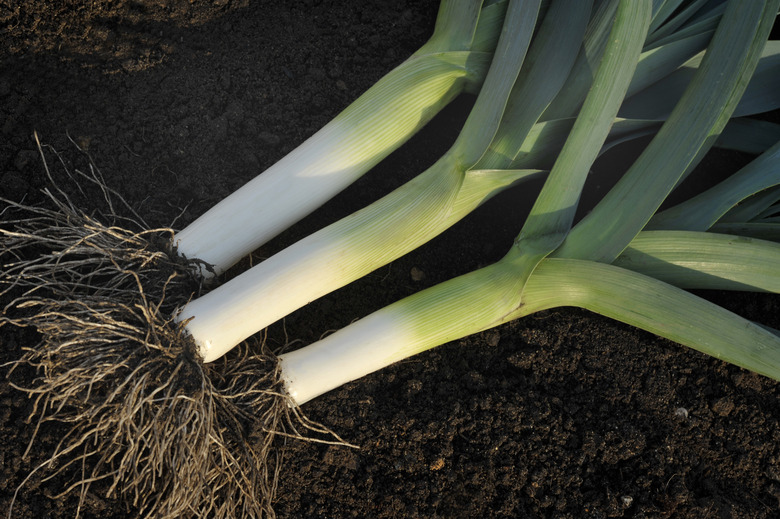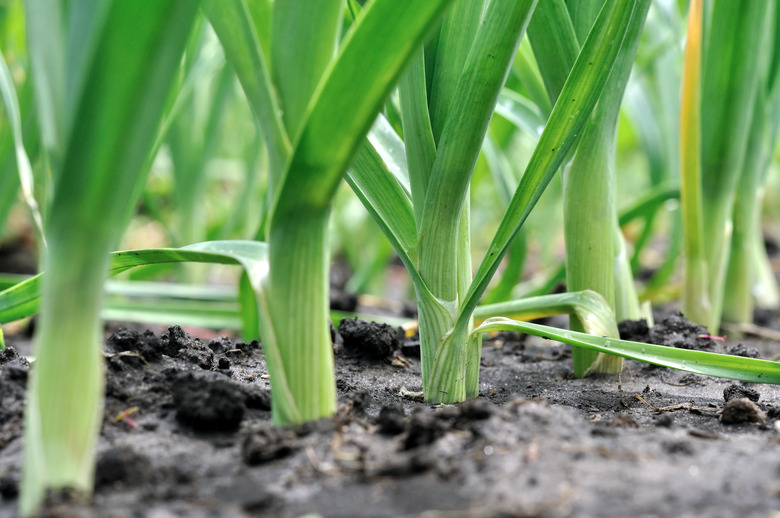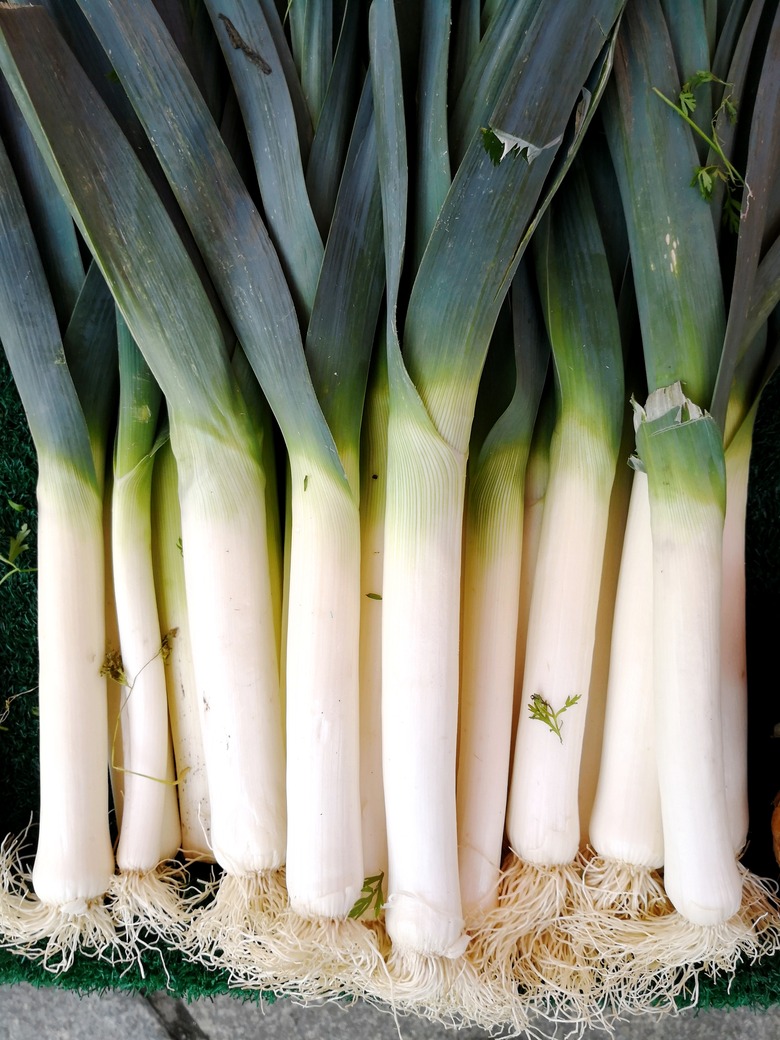How To Grow Leeks
We may receive a commission on purchases made from links.
Leeks (Allium ampeloprasum var. porrum) are members of the onion family, with thick stalks of white and green. Though they're easy to grow and care for, keeping part of the stalk covered with soil and out of sunlight as the plant grows helps keep that area white and tender compared to its leafy green counterparts. These relatively hardy plants are even able to handle a little frost after planting and can be left in the soil well into the cool months to harvest in late autumn or winter in many climates.
Best Uses for Leeks
Best Uses for Leeks
Leeks serve as an excellent substitute for onions in your favorite dishes, offering a milder, slightly sweeter taste than the average onion. They're also great for soups, salads and stews as well as classic specialty dishes, such as leek and potato soup. Roast them with meats and other vegetables or whisk them into your favorite vinaigrette recipes.
When you are getting ready to plant leeks, you have plenty of choices, as these shallow-rooted plants do well in containers or in garden beds. They prefer at least six to eight hours of sunlight a day, so no matter what type of gardening you do, choose a spot that gets full sun. If you are planting leeks in a container, choosing a vessel that's at least 8 inches deep makes it easier to keep the lower part of the leek stalk covered with soil.
How to Grow Leeks
How to Grow Leeks
How to Start Leeks From Seed
How to Start Leeks From Seed
Leeks have a long growing season, typically 120 to 150 days, so start seeds indoors in February or March or about two months before the last frost date in zones that endure some frost, such as zone 6 and colder. This ensures you'll have them in the ground with ample growing time.
- Press seeds 1/4 to 1/2 inch deep into the soil in a small flat or in individual pots of a light soil mix. Space them 3/4 inch apart from one another if you are sowing them all in a flat or a plastic tray used to transport plants.
- Once you see signs of green (in one to two weeks, typically), set the pots or flat in an area that receives plenty of sun, such as near a south-facing window.
- Once the stalks grow 4 inches tall, trim them back to 2 inches tall, repeating as needed using clean shears. Although this is optional, trimming at this stage helps the plant focus its energy downward.
- After 10 to 12 weeks, the leeks are ready to be exposed to the outdoors.
- Harden the plants, or get them used to outdoor temperatures, by taking them outdoors for more hours each day for about a week, after which they're ready to transplant. If you have a cold frame, they can be left in it for five to seven days before transplanting.
How to Start Leeks From a Seedling
How to Start Leeks From a Seedling
Leeks are strong enough to transplant when their stems are about 1/4 inch thick or about 10 weeks or so after germination.
- Mix the garden soil with compost ahead of time to ensure a loose growing environment.
- If you are planting rows of numerous leeks, dig a narrow trench about 6 inches deep for each row, with rows at least 12 inches apart from one another, as the more space the leeks have, the thicker they'll grow. If you prefer not to dig trenches, create a hole 6 inches deep for each leek seedling; this can be done with the handle of a garden tool if the soil is loose enough.
- Plant one leek per hole, watering it in as you plant it. Don't pack the soil around the leek at this point, as the soil will enter the hole on its own.
- Once the leek grows a bit, mound the soil over a couple inches of stalk to help blanch the stalk. This keeps it white and tender and better for recipes. Mound only up to the lowest parts of the stalks on leaves to keep dirt from lodging between the leaves and the stalk.
In What Zone Do Leeks Grow Best?
In What Zone Do Leeks Grow Best?
Although leeks can be planted as an annual in any zone, they prefer cool weather. Climates with cold winters, such as Zones 6 and colder, are especially good for leeks since cool weather improves the slightly sweet flavor. Hot climates, such as zones 9 and warmer, may slow the growth of the plant. This means you may have to adjust the planting time if you live in a warm climate.
In areas with relatively mild winters, leeks can be planted in late summer or early autumn for harvest in winter. Mature leeks are generally hardy enough to thrive even under a layer of snow. A deep layer of straw mulch helps protect the leeks from freezing temperatures if you leave the leeks in the soil during cold weather. In cold climates, it's best to harvest leeks before the ground stays frozen for the winter.
When Should You Plant Leeks?
When Should You Plant Leeks?
Leeks can be planted at several times of the year to stagger their harvest times. Slow-growing varieties may be planted in summer for a spring harvest in mild climates. Fast-growing varieties sown at the end of winter are ready for harvest in late spring, while the slower-growing varieties are ready in late summer. It's best not to plant leeks during the heat of summer, as the heat may stunt their growth.
Choose cultivars based on your plant hardiness zone and the growing rate of the leeks and then plant accordingly. Leeks get their best flavor if they're exposed to cool weather in the 50- to 75-degree range while mature. They're ready for harvest when the stalks are 1 to 2 inches wide and 1 to 2 feet tall.
Soil, Sunlight and Water Recommendations for Leeks
Soil, Sunlight and Water Recommendations for Leeks
Although leeks aren't incredibly needy, they do prefer a nutrient-rich soil, such as a garden soil mixed with compost. Soil pH from 6 to 6.8 is ideal for leeks. The soil should be loose rather than compacted like clay. If you are planting leeks from year to year, choose a new location each time; a plot that housed legumes last year is a good choice. Leeks enjoy at least six hours of sunlight daily to thrive, although they'll tolerate some shade, especially in hotter climates. If you are purchasing leek seeds, check the label to determine how much sunlight your leek cultivar prefers.
Water leeks whenever the top of the soil feels dry or about 1 inch of water per week during the growing season. Mulch placed around the leeks once they're established helps prevent weeds from emerging while also keeping the soil moist. Compost tea, applied once a month around established leeks, helps nourish the plants.
During dry periods, watering is especially important. It's best to water the plants low and near the soil level rather than using a sprinkler that gets the entire leek stalk wet. If you do use a sprinkler, do it early in the day, as this gives the leeks plenty of time to dry off before nighttime. Too much moisture over the leek stalk on a regular basis could cause plant diseases.
How to Propagate Leeks
How to Propagate Leeks
- Save the bottom inch of a leek
—
roots and all
—
and put it in a jar or bowl with just enough water to cover the bottom half of the cutting.
- Gently push toothpicks into the sides of the leek base to help keep it upright if you're using a narrow bowl or jar.
- Place the bowl in an area that receives ample sunlight, and soon you'll see new green growth shooting up from the stalk.
- Once the green leaves reach 2 inches in height, transplant the leek in a nitrogen-rich growing medium or in the garden as you would any leek seedling.
Common Pests and Other Problems for Leeks
Common Pests and Other Problems for Leeks
- Onion thrips Onion thrips are tiny insects that may be black or yellow; they're found between the folds of the leek's leafy stalk. They feed on the plant's juices by chewing into the plants, while their nymphs feed on plant leaves. Look for thrips damage in the form of blotchy white patches that may cause plant death in extreme cases. Leeks are most prone to thrips damage when the plant is still young. Straw mulch helps reduce thrips populations around leeks and onions.
- Leek moths Leeks and onions as well as chives and garlic are also susceptible to damage from leek moths. The larvae of these brown moths are particularly problematic because they eat their way into the leaves, making the plants more susceptible to diseases and other problems. Sticky traps can help minimize leek moth infestations.
- Weeds Although technically not a pest, nearby weeds can be problematic for leeks since the plants compete for space, especially early in the leeks' growth. Mulching the area with straw or a similar material helps prevent weed growth while also helping the soil stay moist, which leeks prefer. Pull weeds as soon as you spot them using care not to damage the shallow roots of the leeks.
Common Diseases for Leeks
Common Diseases for Leeks
Leeks are susceptible to downy mildew, white rot and leek rust.
- Downy mildew Downy mildew creates grayish spots on the leek's leaves. A common cause of downy mildew is watering with a sprinkler or other situations in which the plant's leaves stay wet and do not have adequate air circulation around them. Change your watering habits to ensure the leaves stay as dry as possible.
- White rot White rot, a problem among some members of the onion family, causes leeks to turn yellow and eventually wilt. This is caused by a fungal problem within the soil. The roots may also rot, and all areas underground are also affected. These leeks should be discarded, and the area should not be used for planting for some time, as the soil is the issue.
- Leek rust Leek rust, which shows up as orange spots on the leaves, occurs when the leaves are frequently wet during hot weather. Remove the affected leaves. Since this issue doesn't affect all areas of the plant, the rest of the nonaffected leeks are often healthy. Generally speaking, many of leeks' potential problems are caused by too much moisture.


